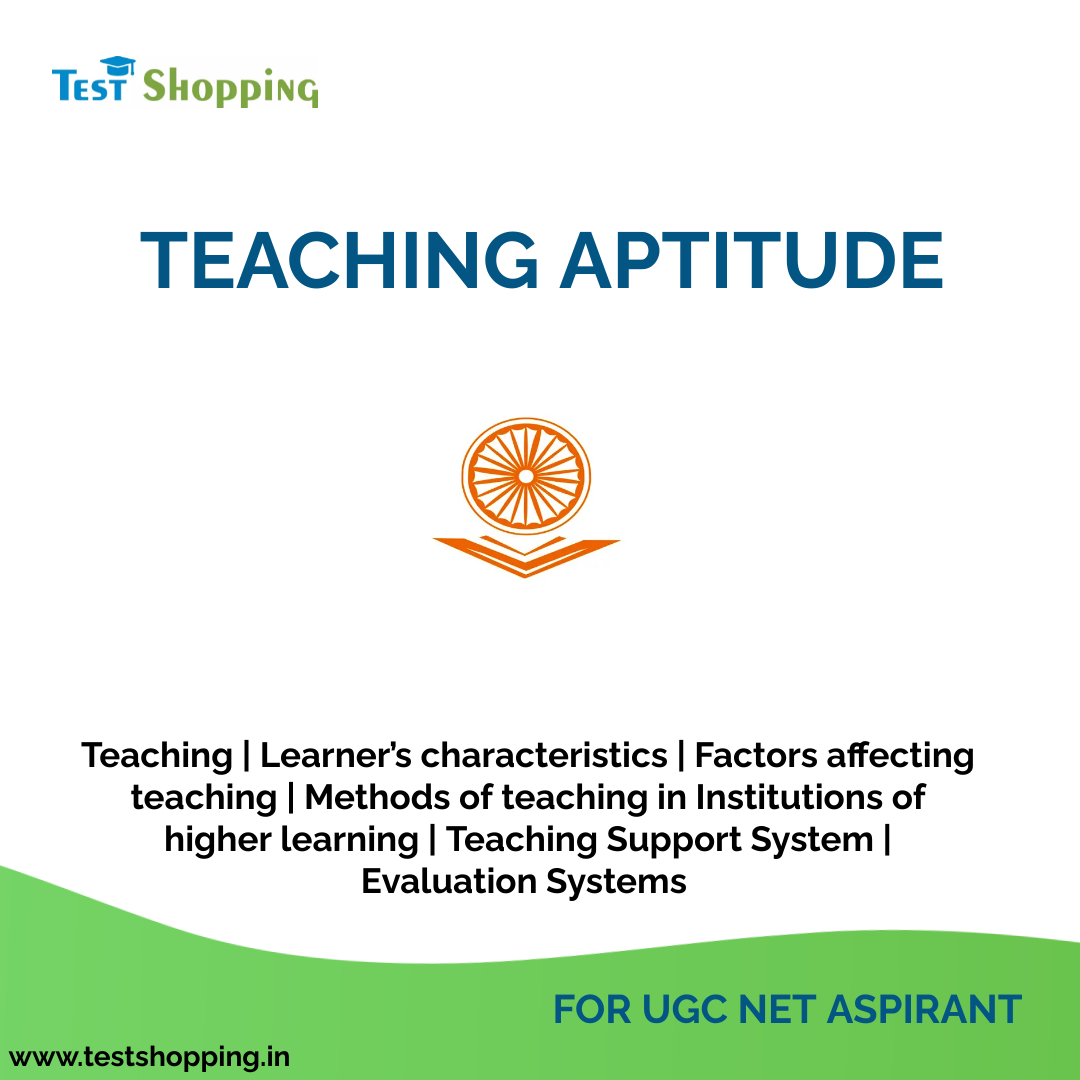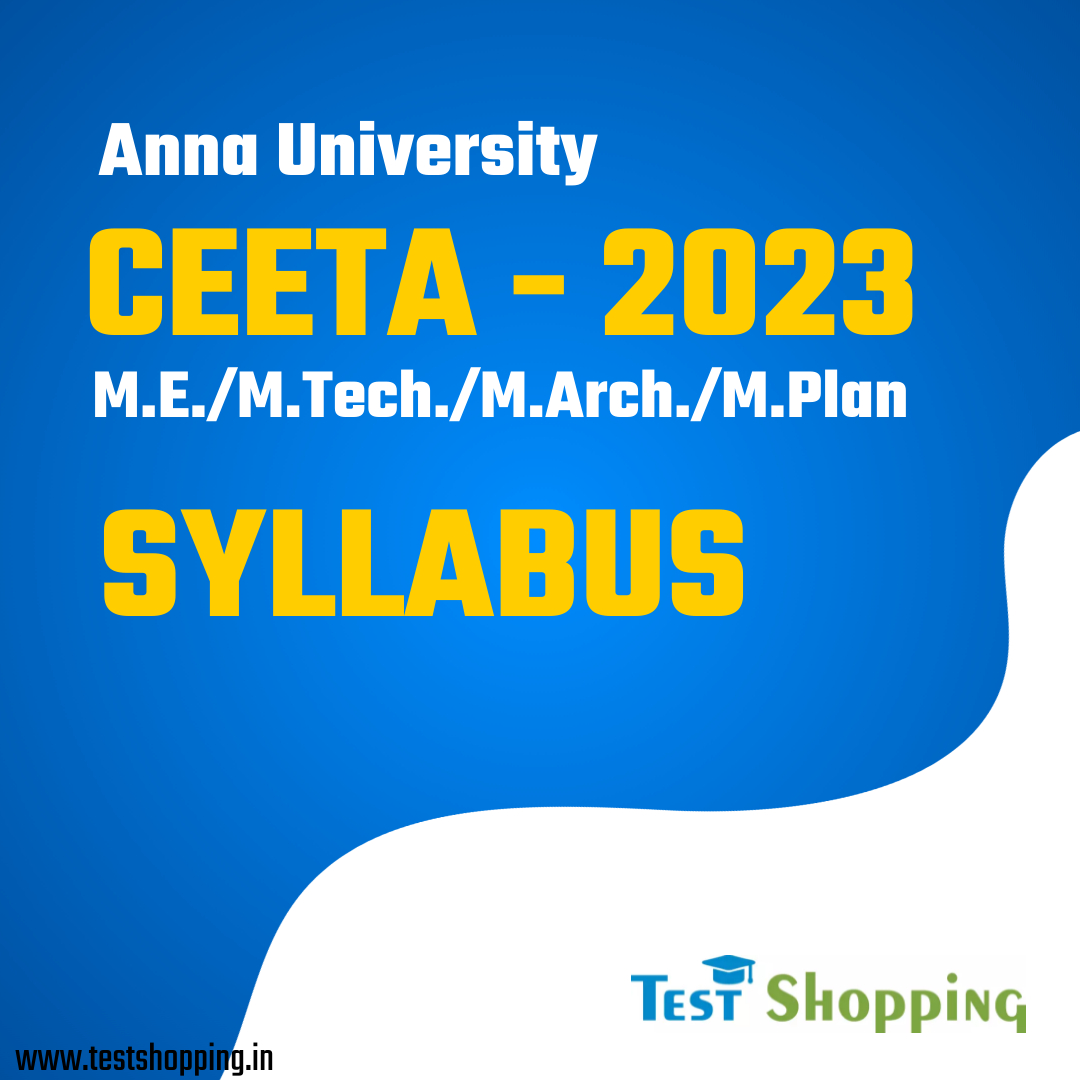
COMMON ENGINEERING ENTRANCE TEST & ADMISSIONS
A single online application form for Common Engineering Entrance Test and Admissions
(CEETA-PG – 2023) for admission to M.E./M.Tech./M.Arch./M.Plan. degree programmes
through single window counseling offered at
a. University Departments of Anna University, Chennai – 600 025
b. Anna University Regional Campuses / Constituent Colleges.
c. Annamalai University
d. Government Engineering Colleges.
COMMON ENGINEERING ENTRANCE TEST & ADMISSIONS SYLLABUS
PART – I
ENGINEERING MATHEMATICS (Common to all Candidates):
Determinants and Matrices: Solving system of equations – Rank of the Matrix – Eigenvalues and
eigenvectors – Reduction of quadratic form to canonical form.
Calculus and Differential Equations: Partial derivatives – Jacobians – Taylor’s expansion –
Maxima and Minima. Linear ordinary differential equations with constant coefficients – Simultaneous
first order linear equations with constant coefficients. Formation of partial differential equation (PDE)
– Solution of first order PDE – Solution of linear higher order PDE with constant coefficients.
Vector Calculus: Double and triple integrations and their applications – Gradient, Divergence, Curl
and Laplacian – Green’s, Gauss divergence and Stroke’s theorem.
Functions of Complex Variables and Complex Integration: Analytic functions – Conformal
Mapping – Bilinear transformation – Cauchy’s integral theorem and integral formula – Taylor and
Laurent Series – Singularities – Residues – Residue theorem and its applications.
Transforms: Laplace Transform – Inverse transforms – Application to solution of linear ordinary
differential equations with constant coefficients. Fourier integral theorem – Fourier transform pair –
Sine and Cosine transforms. - Transform – Inverse Z–transform – Solution of difference equations
using Z– transform.
Numerical Methods: Solution of linear system by direct and iterative methods – Interpolation and
approximation – Numerical Differentiation and Integration – Solving Ordinary Differential Equations.
Applied Probability: Probability and Random variables – Standard Discrete and Continuous
distribution – Moments – Moment generating function and their properties. Two-Dimensional
Random Variables – Covariance – Correlation and Regression.
PART – II
BASIC ENGINEERING & SCIENCES (Common to all Candidates):
Applied Mechanics: Law of Mechanics – Lame’s theorem – Forces, Moments and Couples –
Displacement, velocity and Acceleration – Friction – Moment of Inertia.
Mechanical Engineering: Laws of thermodynamics – Open and closed systems – Equation of state
– Heat and Work.
Physics: Sound – Latices – Ultrasonic flaw detector – X-ray radiography – Interference Fringes –
Planck’s quantum theory – Laser and Fibre Optics.
Material Science: Fracture – Magnetic and Dielectric materials – Conductor and Semi conductor
materials – Ceramic and Super conductor materials.
Civil Engineering: Fluid Statics and Dynamics – Boundary Layer – Pumps and Turbines –
Environmental Pollution.
Electrical Engineering: Ohm’s law – Kirchhoff’s law – A.C. circuits – D.C. machines – Transformers
– Synchronous machines – Instrumentation.-
Computers: Computer organization – Architecture – Arrays – Pointers – User defined function –
C program.
Chemistry: Adsorption – Chromatography – Chemical kinetics – Electrochemistry – Spectroscopy –
Fuels and Combustion.
PART – III
ELECTRICAL AND ELECTRONICS ENGINEERING:
Electrical Circuits and Fields: KCL, KVL, Nodal & Mesh analysis, transient response of D.C and A.C
networks; sinusoidal steady-state analysis; resonance in electrical circuits; concepts of ideal voltage
and current sources, network theorems, driving point admittance and transfer functions of two port
network, three phase circuits; Fourier series and its application; Gauss theorem, electric field intensity
and potential due to point, line plane and spherical charge distribution, dielectric, capacitance
calculations for simple configurations; Ampere’s and Biot-Savart’ law, inductance calculations for
simple configurations.
Electrical Machines: Single phase transformer – equivalent circuit, phasor diagram, tests, regulation
and efficiency; three phase transformer –connections; auto transformer; principles of energy
conversion, windings of rotating machines; D.C generators and motors-characteristics, starting and
speed control, armature reaction and communication: three phase induction motors-performance
characteristics, starting and speed control; single-phase induction motors; synchronous generators –
performance, regulation; synchronous motors – starting characteristics, applications, synchronous
condensers; fractional horsepower motors: permanent magnet and stepper motors.
Power Systems: Electric power generation – thermal, hydro, nuclear; transmission line parameters;
steady –state performance of overhead transmission lines and cables and surge propagation;
distribution system, insulators , bundle conductors, corona and radio interferences effects; per-unit
quantities; bus admittance and impedance matrices; load flow; voltage control and power factor
correction; economic operation; symmetrical components, analysis of symmetrical and unsymmetrical
faults; principle of over current, differential and distance protections; concepts and solid state relays
and digital protection; circuit breakers; principles of system stability –swing curves and equal area
criterion; HVDC system – Principle of operation, control and design consideration, HVDC circuit
breaking; FACTS - Reactive power control, Uncompensated transmission line, Series compensation,
SVC, thyristor control, series capacitor, static synchronous compensator, UPFC and applications.
Control Systems: Principles of feedback; transfer function; block diagram; steady –state errors;
stability-Routh and Nyquist criteria; Bode plots; compensation; root loci; elementary state variable
formulation; state transition matrix and response for Linear time Invariant systems.
Power Electronics and Drives: Semiconductor power devices-diodes, transistors, thyristors, triacs,
GTO, MOSFETs and IGBTs-static characteristic and principles of operation; triggering circuits; phase
control rectifiers; bridge converters-fully controlled and half controlled; principles of choppers and
inverters, basic concepts of adjustable speed dc and ac drives.
Microprocessor and Microcontrollers: Microprocessor : General 8 bit microprocessor Architecture8085, 8086 processor – Architecture, Memory, I/O interfacing, Instruction set, Addressing modes,
Timing diagram & delays, Machine cycles, Interrupts, counters, Assembly language programming.
Microcontrollers: 8 bit microcontroller -8051 architecture, bus configuration, Instruction sets,
programming & applications.
Digital Signal Processing: Analog signals - sampling & Aliasing- Discrete time signals & systems –
LTI systems – Convolution sum-Difference equation representation-Z Transform & its Inverse –
Discrete Fourier series & Fourier transform- Radix 2 FFT – Decimation in me and frequency – Inverse
DFT using FFT – Analog Butterworth & Chebyshev filter design –IIR & FIR filter design and
Realization.
High Voltage Engineering: Causes of overvoltages and its effects on power system – Lightning,
switching surges and temporary overvoltages – concepts of reflections and refraction of travelling
waves. Dielectric breakdown- Gaseous breakdown – Vacuum breakdown, Corona discharges –
Generation of high voltage, High current and its measurements – DC, AC, impulse voltages and
currents; High Resistance with series ammeter – Dividers, Resistance, Capacitance and Mixed dividers
– Peak Voltmeter , CVT, Electrostatic Voltmeters – Sphere Gaps – High current shunts; High voltage
testing of electrical power apparatus as per International and Indian standards – Insulation
Coordination.
Electric energy – Conservation and utilization: Fundamentals of Electric drives – choice and
applications; traction motors – characteristic features – electric braking train movement and energy
consumption; Design of illumination systems and various lighting schemes; Electric heating – methods
of electric heating and its types – Electric welding - Principles of the conversion of solar radiation into
heat; Solar Collectors-flat-plate collectors – concentrating collector – cylindrical parabolic; Wind
energy conversion system – basic principles – site selection – basic components – Classification of
WECS – Types of wind machines.
ELECTRONICS AND COMMUNICATION ENGINEERING
Circuit Analysis: DC Circuit analysis, Thevenin’s and Norton’s equivalent circuits, Sinusoidal steady
state analysis, Transient and resonance in RLC circuits
Electronic Devices: Diodes, Bipolar Junction Transistors, FET, MOSFET, UJT, Thyristor.
Electronic Circuits: Small signal amplifiers using BJT and FET devices, Large signal amplifiers,
Power supplies, Feed back amplifiers, Oscillators, Pulse shaping circuits.
Digital Electronics: Logic
gates, Combinational circuits, Sequential circuits.
Linear Integrated Circuits: Operational
amplifiers and its applications, PLL, Voltage regulators, A/D and D/A converters.
Measurements
and Instrumentation: Transducers, Digital Instruments, Display and Recording systems.
Microprocessor and its applications: Microprocessors-8085 and 8086 architectures and
interfaces, Micro-controller and applications.
Electromagnetic Fields: Static Electric and Magnetic fields, Time varying Electric and Magnetic
fields, Maxwell equations.
Transmission Lines and Networks: Transmission line equations,
impedance matching, Filters.
EM waves and waveguides: Guided waves, Rectangular and
cylindrical waveguides.
Antennas and Propagation: Aperture antennas, arrays, Propagation of
radio waves.
Microwave Engineering: Microwave tubes, semiconductor devices, Passive
components, Microwave measurements.
Communication Theory and Systems: AM, FM and PM, Sampling and Quantization, PCM, DM,
ADM, Multiplexing. Digital Communication: Base band signaling, Band pass signaling, Error
control coding, Spread spectrum techniques.
Optical Communication: Optical Fibers, optical transmitters and receivers.
Signals and Systems: Continuous time signals and systems-Fourier Transform, Laplace transform,
Discrete time signals and systems-DTFT, DFT, Z-Transform. Digital Signal Processing: IIR and
FIR filters, Realization and implementation, Quantization effects.
Control Systems: Transfer
function, Time and frequency response analysis, Stability analysis, state variable analysis
Computer Communication Networks: Definition of
layers, data link protocols, Network interconnection. Message routing technologies, End-End
protocols.
MECHANICAL ENGINEERING
Mechanics, Kinetics and Dynamics :
Statics of Particles, Equilibrium of Rigid bodies, Properties of Surfaces and Solids, Dynamics of
Particles, Friction and Elements of Rigid Body Dynamics, Basics of Mechanisms, Gears and Gear
Trains, Friction in Machine Elements, Force Analysis, Balancing, Single Degree Free Vibration, Forced
Vibration, Mechanisms for Control and Vibration.
Strength of Materials and Design :
Stress, Strain and Deformation of Solids, Transverse Loading on Beams and Stresses in Beams,
Torsion, Deflection of Beams, Energy Principles, Thin Cylinders and Thick Cylinders, Spherical Shells,
Fundamentals of Design for Strength and Stiffness of Machine Members, Design of Shafts and
Couplings, Design of Fasteners and Welded Joints, Design of Springs, Design of Engine parts, Design
of Bearings, Design of Flywheels, Design of Transmission Systems for Flexible Elements, Spur Gears
and Parallel Axis Helical Gears, Bevel Gears, Worm Gears and Crossed Helical Gears, Design of Gear
Boxes, Design of CAM, Clutches and Brakes.
CAD / CAM / CIM / FEA :
Fundamentals of Computer Graphics, Geometric Modeling, Visual Realism, Assembly of Parts, CAD
Standards, Fundamentals of CIM, Production Planning and Control and Computerized Process
Planning, Cellular Manufacturing, Flexible Manufacturing System and Automated Guided Vehicle
System, Industrial Robotics, One Dimensional Problems in FEA, Two Dimensional Scalar Variable
Problems, Two dimensional vector variable Problems, Isometric Parametric Formulation.
Materials Science and Metallurgy :
Constitution of alloys and phase diagrams, steels, cast iron, TTT diagram, heat treatment of ferrous
and non-ferrous metal, surface modification techniques, non-metallic materials, mechanical properties
and testing, crystal defects and strengthening mechanisms, conducting and semi conducting
materials, magnetic and dielectric materials, Engineering ceramics, Engineering and commodity
polymers.
Production Technology :
Foundry Technology, Hot and Cold working, metal forming processes, metal joining processes,
welding metallurgy, welding defects, Metal cutting, center lathe and special purpose lathe, drilling,
milling, grinding, gear cutting, broaching unconventional machining processes, CNC machine tools,
Part programming.
Metrology and Measurements :
Linear and angular measurements, Interferometry-laser interferometers – Types, Computer Aided
Inspection, Basic concept of CMM- Types of CMM, Machine vision, Form measurement-StraightnessFlatness, Roundness, Surface finish measurement, Measurement of power, flow and temperature.
Thermodynamics: Basic concepts, Zeroth, First and Second laws of thermodynamics;
thermodynamic system and processes; Carnot cycle. irreversibility and availability; behaviour of ideal
and real gases, thermodynamic relations, properties of pure substances, calculation of work and heat
in ideal processes; analysis of thermodynamic cycles related to energy conversion, Fuel and
combustion.
Heat and Mass Transfer: Modes of heat transfer; one dimensional heat conduction, resistance
concept, electrical analogy, unsteady heat conduction, fins; dimensionless parameters in free and
forced convective heat transfer, various correlations for heat transfer in flow over flat plates and
through pipes; thermal boundary layer; effect of turbulence; radiative heat transfer, black and grey
surfaces, shape factors, network analysis; heat exchanger performance, LMTD and NTU methods. Basic Concepts of Mass transfer – Diffusion Mass Transfer – Fick’s Law of Diffusion – Steady state
Molecular diffusion – Convective Mass Transfer – Momentum, Heat and Mass Transfer Analogy –
Convective Mass Transfer Correlations.
Applications: Power Engineering: Steam Tables, Rankine, Brayton cycles with regeneration and
reheat. I.C. Engines: air-standard Otto, Diesel cycles. Refrigeration and air-conditioning: Vapour
refrigeration cycle, heat pumps, gas refrigeration, Reverse Brayton cycle; moist air: psychrometric
chart, basic psychrometric processes. Turbomachinery: Pelton-wheel, Francis and Kaplan turbines –
impulse and reaction principles – velocity diagrams.
Fluid Mechanics: Fluid properties; fluid statics, manometry, buoyancy; control-volume analysis of
mass, momentum and energy; fluid acceleration; differential equations of continuity and momentum;
Bernoulli’s equation; viscous flow of incompressible fluids; boundary layer; elementary turbulent flow;
flow through pipes, head losses in pipes, bends etc.
CIVIL ENGINEERING
Structural Engineering: Mechanics: Stress-Strain Relationships – Principal stresses and Principal
strain in two dimension and three dimension. Composite Bars – Composite Beams – Elastic
Constants. Beams and Bending – Shear Force and Bending Moment Diagrams – Flexural and shear
Stresses. Slope and Deflection of Beams. Thin and Thick Cylinders. Torsion. Theories of Failure –
Unsymmetrical Bending – Curved Beams – Theories of Columns. Combined Direct and Bending
Stresses.
Structural Analysis: Static and Kinematic Indeterminacy – Energy Principles – Deflection of pin
jointed plane frames – rigid frames. Classical Method of Analysis of indeterminate structures (Slope
deflection and Moment Distribution) – Matrix Method. Arches and Suspension Bridges – Influence
Line for Determinate and Indeterminate Structures. Plastic Analysis of Structures.
Building Materials: Cement – Concrete – properties of ingredients – Mix Design – Quality Control –
Special Concrete – Concreting Methods – Brick – Brick Masonry – Stone – Timber – Steel.
Concrete Structures: Design Methods – Limit State Design for beams, slabs, columns and footings
– retaining walls – water Tanks. Prestressed Concrete – Principles – Methods – Losses – Deflection –
Design.
Steel Structures: Steel Sections – Connections – Design of Tension and Compression Members –
Beams, Column Bases – Plate Girders and Trusses.
Soil Mechanics: Nature of soil – phase relationships – soil classification; Soil water – static pressure
– effective stress principle; permeability – seepage; Stress distribution in soil – Consolidation
(Terzaghi’s one dimension consolidation theory); Compaction shear strength of soil – Mohr -
Coulomb theory – determination of shear strength by different methods; Slope stability analysis –
protection measures.
Foundation Engineering: Site investigation – scope and objectives – drilling techniques – depth
and spacing of boreholes – sampling techniques – penetration tests (SPT and SCPT) – plate load test
– selection of foundation; Foundation types – shallow foundation – bearing capacity (Terzaghi’s
Theory and BIS formula) – allowable bearing pressure – bearing capacity from field tests –
settlement of foundation – allowable settlement – Codal provisions; Design of foundations – Isolated,
combined and raft foundation; Pile foundations – static and dynamic pile driving formulae
(Engineering News and Hiley method) – Pile groups – capacity and settlement – Codal provisions –
pile load test – negative friction on piles; Earth pressure theories – Earth pressure on retaining walls
– stability analysis of retaining wall.
Transportation Engineering: Highway Planning: Road Classification, Geometric Design of
Highways, Construction of Earth, WBM, Bituminous and concrete roads, Design of flexible and rigid
pavements. Drainage of roads, Maintenance of roads. Railways, Airways, Docks and Harbour
Planning: Railway alignment components of permanent way, geometric design Airport planning,
components of airport, site selection, planning for terminal building, runways. Harbour planning,
components of harbour, inland water transport. Traffic Engineering: Traffic characteristics, Traffic
surveys, Traffic Signals, Road markings and signs.
Water Resources Engineering: Fluid Mechanics and hydraulics: Properties of fluids. Fluid statics
and relative equilibrium. Basic concepts of fluid flow – kinematics and dynamics. Concept of system
and control volume application to continuity, momentum and energy equations. Dimensional analysis
and model studies. Laminar and turbulent flow through pipes. Boundary layers. Steady uniform and
gradually varied flow in open channels. Rapidly varied flows. Turbines and pumps and positive
displacement pumps.
Hydrology and Ground Water: Hydrometeorology. Hydrologic cycle. Precipitation and its
measurements. Abstractions. Runoff estimation. Hydrograph analysis. Unit Hydrograph. Hydrologic
extremes floods and droughts. Rainwater harvesting. Properties of aquifer. Groundwater
development. GEC norms. Well hydraulics. Steady and unsteady flows. Ground water quality.
Irrigation Engineering: Irrigation system. National water policy. Components of irrigation network.
Design of lined and unlined channels. Waterways, head works, gravity dams and spillways. Design of
weirs on permeable foundation. Soil water relations. Crop water requirements. Irrigation scheduling
and methods. Duty, delta and base period. Irrigation water quality. Irrigation water management.
Participatory approach
Environmental Engineering: Water and waste water Engineering; Water requirements; water
demand; quality standards; Development of water supply source, conveyance system; basic unit
processes and operations for water treatment; water distribution; sewage characteristics; sewage
treatment, primary and secondary treatment of sewage, sludge disposal, sewage disposal.
Air Pollution and Control: Types of Pollutants, their sources and impacts, air pollution meteorology,
air pollution control, air quality standards and limits.
Noise pollution and Control: Impacts of noise, permissible limits of noise pollution, measurement
of noise and control of noise pollution
Surveying: Chain surveying, compass surveying – plane table surveying – levelling – theodolite
surveying – Temporary and permanent adjustments for level and theodolite – trigonometric levelling
– tacheometry – traversing – contouring – Computation of areas and volumes. Curve Setting –
simple, compound and reverse curves – transition curves – vertical curves – Electromagnetic distance
measurement – Total station – construction surveying – hydrographic surveying – route survey –
triangulation – astronomical survey.
COMPUTER SCIENCE AND ENGINEERING / INFORMATION TECHNOLOGY
Applied Probability And Operations Research: Random Processes, Probability Distributions,
Queuing Models and Simulation, Testing of Hypothesis, Design of Experiments.
Discrete Mathematical Structures: Formal Language and Automata - Graph Theory.
Compiler Design: Optimization – Code Generation – Implementation – Principles of Programming
Languages – Programming Paradigms.
Operating Systems And System Software: Process Management, Storage Management, I/O
Systems, Design and Implementation of LINUX OS, assemblers, Loaders, Linkers, Macro Processors.
Distributed Systems: Communication and Distributed Environment, Distributed Operating
Systems, Distributed Shared Memory, Protocols, Fault Tolerance and Distributed File Systems,
Distributed Object Based Systems.
Programming And Data Structures: Problem Solving Techniques, Trees, Hashing and Priority
Queues, Sorting, Graph, Heap Search.
Algorithm Analysis And Design Techniques: Dynamic Programming, Greedy Algorithms,
Advanced Algorithms, NP Completeness and Approximation Algorithms.
Microprocessors And Microcontrollers - Computer Architecture And Organization : Digital
Fundamentals, Combinational Circuits, Synchronous and Asynchronous Sequential Circuits,
Instruction Set Architecture(RISC,CISC,ALU Design), Instruction Level Parallelism, Processing Unit
and Pipelining, Memory Organization.
Digital Signal Processing: FFT, Filter Design.
Computer Networks: Data Communication Systems, Applications.
Database Management Systems: Relational Model, Database Design, Implementation
Techniques, Distributed Databases, Object Oriented Databases, Object Relational Databases, Data
Mining and Data Warehousing.
Software Engineering Methodologies : Software Product and Processes - Software
Requirements Management - Requirement Engineering, Elicitation, Analysis, Requirements
Development and Validation, Requirements Testing - Object Oriented Analysis And Design – Modular
Design, Architectural Design, User Interface Design, Real Time Software Design, System Design,
Data acquisition System - Software Testing And Quality Assurance - SQA Fundamentals, Quality
Standards, Quality Metrics, Software Testing Principles, Defects, Test Case Design Strategies,
Software Quality and reusability, Software Project Management, Software Cost Estimation, Function
Point Models, Software Configuration Management, Software Maintenance.
Artificial Intelligence: Intelligent Agents, Search Strategies, Knowledge Representation, Learning,
Applications.
Mobile Computing: Wireless Communication Fundamentals, Telecommunication Systems, Wireless
Networks.
Security In Computing : Program Security, Security in Operating Systems, Database and Network
Security, Scientific Computing, Information Coding Techniques, Cryptography, Network Security.

admin
Admin roleCategories
Popular posts
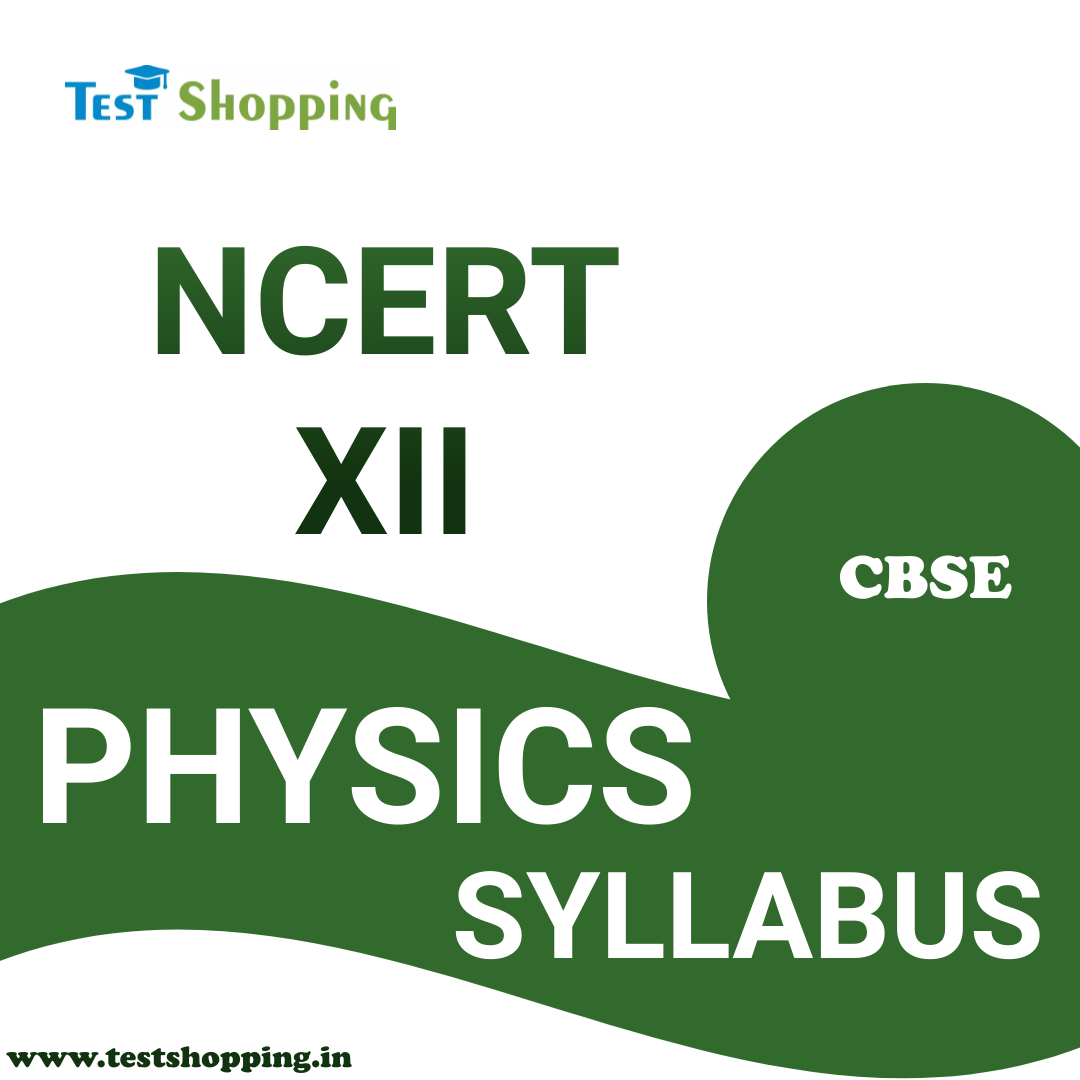
CBSE PHYSICS SYLLABUS
2023 Apr 14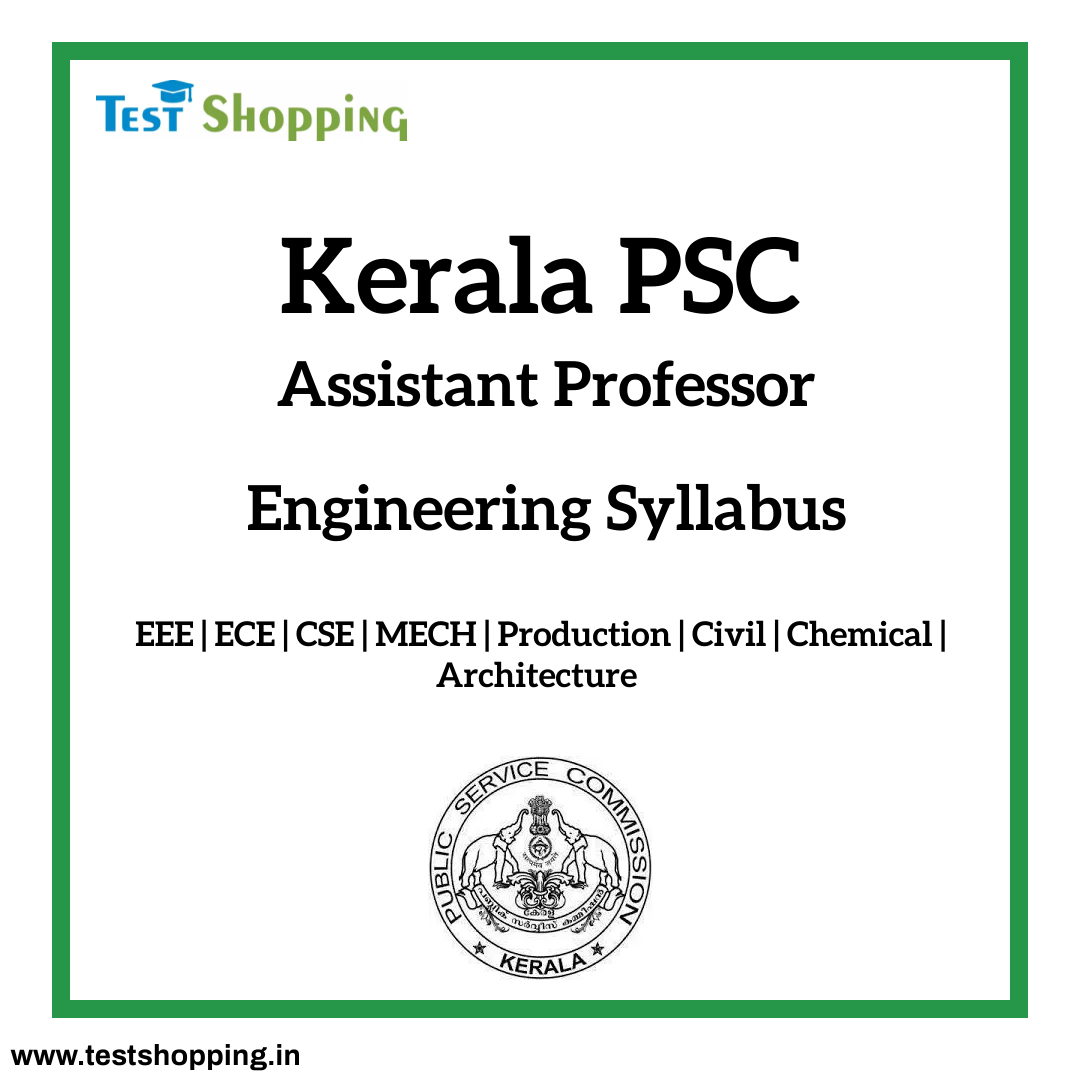
Kerala PSC Assistant Professor Engineering ...
2023 Jan 10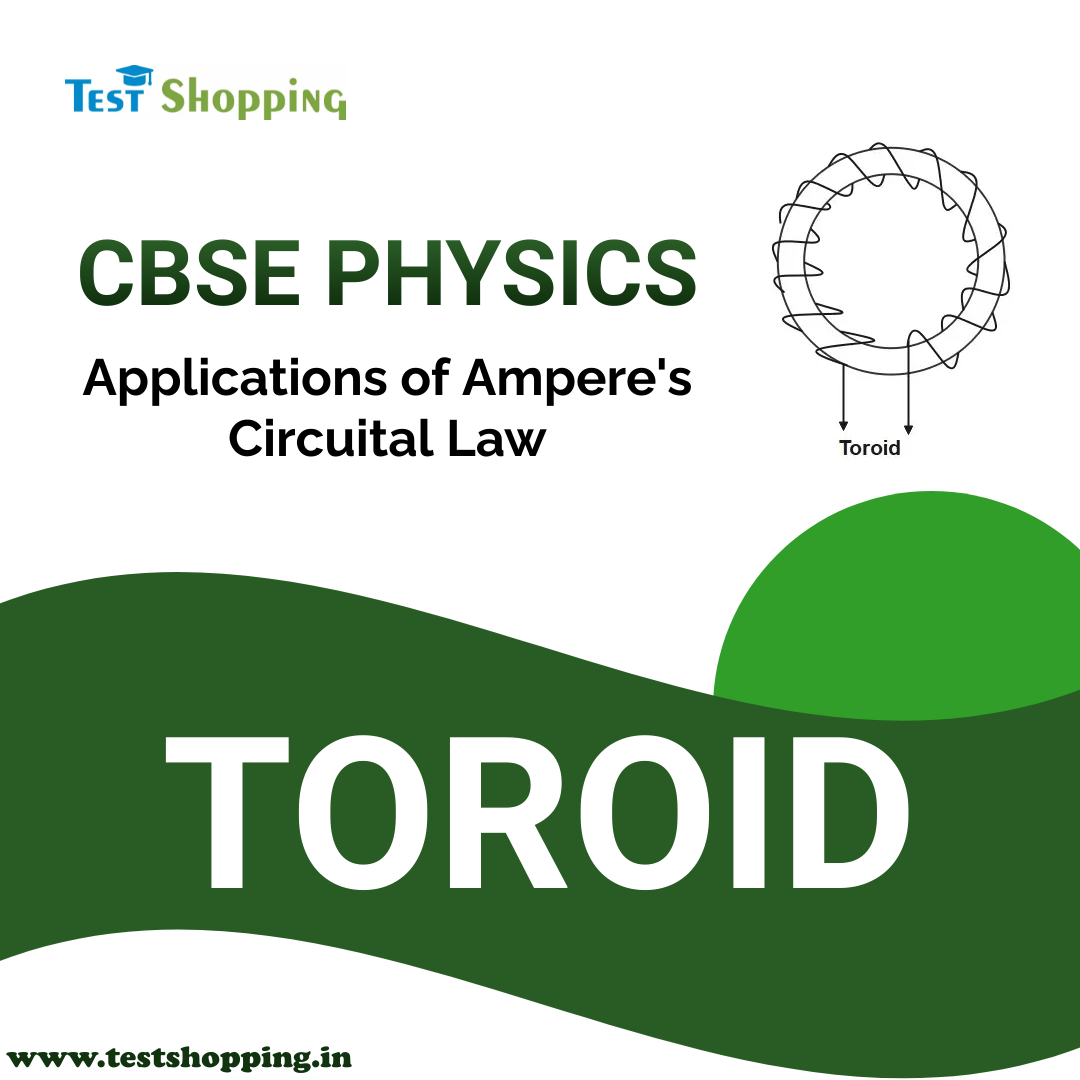
Magnetic Field Due to Toroid
2023 Jul 09